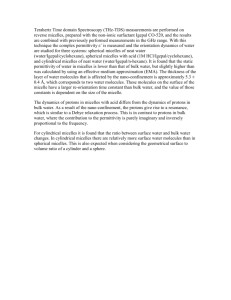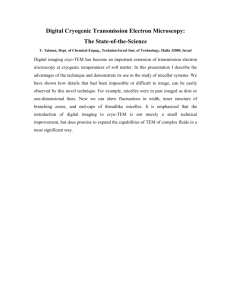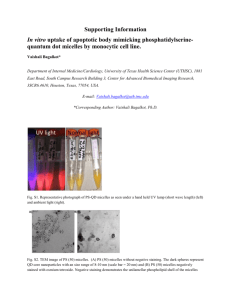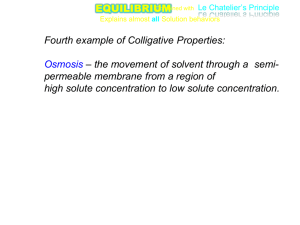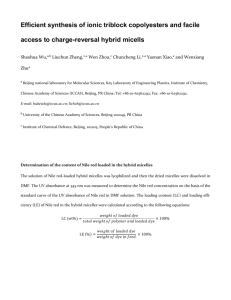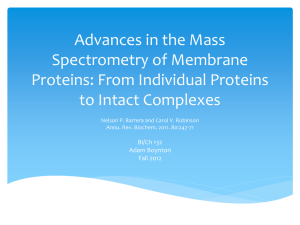Characterization of Polystyrene-block-poly(acrylic acid) Micelles
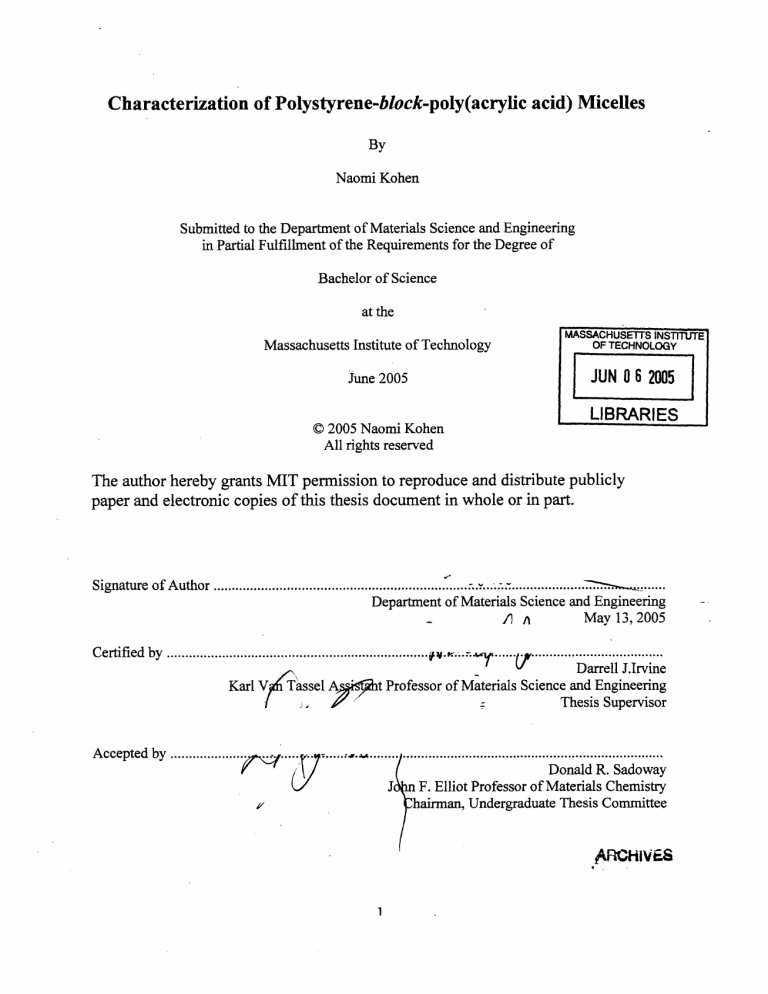
Characterization of Polystyrene-block-poly(acrylic acid) Micelles
By
Naomi Kohen
Submitted to the Department of Materials Science and Engineering in Partial Fulfillment of the Requirements for the Degree of
Bachelor of Science at the
Massachusetts Institute of Technology
MASSACHUSETIS INST
OF TECHNOLOGY
TTVTE
June 2005 JUN 6 2005
LIBRARIEE
I
4
© 2005 Naomi Kohften
All rights reserved
The author hereby grants MIT permission to reproduce and distribute publicly paper and electronic copies of this thesis document in whole or in part.
Signature of A uthor
Department of Materials Science and Engineering
-
~A n May
13,
2005
C ertified by
.......................................................................
Cete Darrell J.Irvine
Karl V14 assel A st Professor of Materials Science and Engineering
/
.,
_- Thesis Supervisor
Accepted by ...........
AJbn
.................
DonaldR. Sadoway
J F. Elliot Professor of Materials Chemistry hairman, Undergraduate Thesis Committee
AflCtlVuS
1
Characterization of Polystyrene-block-poly(acrylic acid) Micelles
In Solution and Assembled on Solid Substrates
By
Naomi Kohen
Submitted to the Department of Materials Science and Engineering on May 13, 2002 in Partial Fulfillment of the
Requirements for the Degree of Bachelor of Science in Materials Science and Engineering
ABSTRACT
Several parameters that affect the formation, size and spatial distribution of micelles of poly(styrene-block-acrylic acid) (PS-b-PAA) in organic solvents or assembled on solid substrates have been investigated. The micelles were characterized in the solvated state using Dynamic
Light Scattering, and were imaged and characterized in the dry thin film state using Atomic
Force Microscopy. Micelle size in solution followed scaling laws based on the ratio of the two block copolymer segments. Micelle size was not affected by the addition of PS homopolymer or salt, whereas micelle diameter did increase with the addition of PAA homopolymer both in solution and in the dry state on sold supports. Furthermore, micelles formed in toluene, but they did not form in tetrahydrofurane, chloroform or hexane. In terms of spatial distribution in the dry state, the only parameters which affected spacing, and therefore density, were annealing conditions and addition of PAA homopolymer. Annealing near or below the glass transition temperature for 16 hours increased the order of the films, as was demonstrated by Fast Fourier
Transforms of their AFM images. Annealing for longer periods of time or at temperatures significantly above the glass transition temperature destroyed the micelles.
2
Thesis Supervisor: Darrell J. Irvine
Title: Karl Van Tassel Assistant Professor of Materials Science and Engineering
Acknowledgements
I would like to thank my thesis advisor Professor Darrel Irvine for guidance in the project and Andy Miller, whose mentorship was invaluable through out the project. I would like to thank Libby Shaw at the CMSE for Atomic Force Microscopy training and Marco Lattuda from the Hatton Lab at MIT for access to and assistance with his lab's Dynamic Light Scattering instruments. I would also like to thank Ryan Bennett of the Cohen Lab at MIT for his assistance and collaboration.
TABLE OF CONTENTS
Title Page .......................................................................................
Abstract ..........................................................................................
Acknowledgements ............................................................................
Table of Contents ..............................................................................
List of Figures ..................................................................................
1. Introduction ...................................................................................
1 p. 2 p. 3 p. 4 p. 5 p. 6
1.1 Motivation ........................................................................
p. 7
1.2 Atomic Force Microscopy .......................................................
1.3 Dynamic Light Scattering .......................................................
2. Materials and Methods
2.1 Micelle Preparation ..............................................................
2.2 Substrate Selection ...............................................................
2.3 Spin Casting ......................................................................
2.4 Dynamic Light Scattering ......................................................
p. 8 p. 8 p. 9 p. 10
10 p. 11
2.5 Atomic Force Microscopy .......................................................
3. Results and Discussion ................................................................... 11
3.1 Affects of Chain Length and Additives of Micelle Size in Solution.......p. 12
3.1.1 Solvent ..................................................................
3.1.2 Chain Length ........................................................ p. 12 p. 12
3.1.3 Ionic crosslinkers ......................................................
p. 15
3.1.4. Polystyrene homopolymer ........................................................p. 16
3.1.5 Polyacrylic acid homopolymer ..................................................p. 17
3.2 AFM (dry state/surface) of micelle size and spacing ........................
3.2.1 Chain length ............................................................
p. 18 p. 18
3.2.2. Ionic crosslinkers .....................................................
4. Conclusions ................................................................................
5. Future Work ..............................................................................
Appendix .......................................................................................
References ......................................................................................
p. 24
3.2.3 Polystyrene homopolymer ........................................................ p. 25
3.2.4 Polyacrylic acid homopolymer ......................................
p. 27
3.2.5 Annealing ..................................................................................
p. 28 p. 34 p. 34 p. 36 p. 28
4
LIST OF TABLES AND FIGURES
TABLES
Table 1: Effects of Concentration on Hydrodynamic Radius ....................................p. 13
Table 2: Effect of Block Length on Hydrodynamic Radius ..............................
p. 13
Table 3: Effect of Ionic Crosslinkers on Hydrodynamic Radius .......................
p. 16
Table 4: Effect of Polystyrene on Hydrodynamic Radius ...............................
p. 16
Table 5: Effect of Polyacrylic Acid oh Hydrodynamic Radius .........................
Table 6: Annealing Conditions ..............................................................
p. 18 p. 28
GRAPHS
Graph 1: Halperin Scaling Law ........................................................... p. 15
FIGURES
Figure 1: PS, PAA and micelle structure ...................................................
p. 6
Figure 2: Distribution of Micelle Sizes for PS(16.5)-b-PAA(4.5) ..............................p. 14
Figure 3: Varying Block Lengths of PS-b-PAA on glass ................................. p. 19
Figure 4: PS966.5)-b-PAA(4.5) on glass .................................................................
p. 21
Figure 5: PS(16.5)-b-PAA(4.5) on glass ....................................................
p. 23
Figure 6: PS(16.5)-b-PAA with and without PbAc on PEM ...............................
p. 24
Figure 7: PS(16.5)-b-PAA(4.5) with FeCl3 on PEM .......................................
p. 25
Figure 8: PS(16.5)-b-PAA(4.5) with and without PS homopolymer on PEM .........
p. 26
Figure 9: PAA homopolymer increases micelle size ......................................
p. 27
Figure 10: PS(16.5)-b-PAA(4.5) annealed at 50°C for 16 hours .........................
p. 29
Figure 11: PS(16.5)-b-PAA(4.5) annealed at 100°C for 16 hours ........................
Figure A. : PS(16.5)-b-PAA(4.5) with FeC13 on PEM 5tm * 5 tm ....................
p. 30
Figure 12: 3D plot of 2D FFT of annealed and unannealed PS(16.5)-b-PAA(4.5) ..p. 31
Figure 13: 1D plot of 2D FFT of annealed and unannealed PS(16.5)-b-PAA(4.5)... p. 33 p. 27
Figure A.2: PS(16.5)-b-PAA(4.5) annealed at 150°C for 16 hours ......................
p. 27
Is
1. Introduction
Ampiphilic block copolymers, which are comprised of a hydrophilic block followed by a hydrophobic block, are known to self assemble into micellar structures in nonpolar organic solvents. In particular, previous studies have demonstrated that PS-b-PAA can form reverse micelles in organic solvents. The polyacrylic acid forms the core of the micelle and the polystyrene forms the corona of the micelle.
Polystyrene
-CH
2
-CH-CH
2
-CH-C H
2
-C H-C *-C H-CH
2
-C H-
-CH
2
Polyacrylic Acid
-CH-CH
2
-CH-C
2
-C H-C H-C H-CH-CH-C
I I I I I
2
-C H-
I
0O OH or OH OH OH OH OH
Micelle Structure
P
Figure 1: polystyrene and polyacrylic acid chemical structure. The bottom image is the micelle structure based on Daoud-Cotton Blob model'. Polystyrene forms the corona of the micelle and polyarcylic acid form the core of the micelle.
. It has also been shown that when these micelles are deposited on a substrate, they can be ruptured by treatment with a base that forces swelling
2
. After rupture, exposed carboxylic acid
AS
groups of the PAA block can bind a variety of chemicals, and this capability can be exploited for biosensors.
1.1 Motivation
We have proposed that open micelle films (micelles that are ruptured after they are adhered to a solid substrate) can be used to create an immune cell based biosensor. One approach involves attaching dendritic cells to the film created by the micelles. The dendritic cells can be attached to adhesion ligands that are bound to the carboxylic acids exposed in the cores of the ruptured micelles. For this particular project, it is necessary to have controlled spacing between the micelles that mimic the physiological separation between adhesion sites in the extracellular matrix, or elsewhere in the body. The spacing between micelles, and the number of exposed functional groups, will be crucial in determining the morphology and function of the cell. When dendritic cells cluster their cadherin receptors, they remain in an
"immature" "sensing" state
3
. Additionally, the motility of the cell will also be affected by the spatial distribution of the adhesion ligands. Controlling the size of the micelles and their shape
(round versus elliptical) will control the spatial distribution of adhesion ligands.
In this work some parameters that were assumed to affect the size and spatial distribution of micelles were investigated. The lengths of the individual blocks of the diblock copolymer were varied and the solvent type was varied. Additionally, salts and homopolymers of PS and
PAA were introduced to the solutions. Finally, some samples were annealed at temperatures below and above the assumed Tg of the diblock copolymer because it was assumed that annealing could increase order in the thin film state.
7
1.2 Atomic Force Microscopy
Atomic force microscopy was used to image the surface of the micellar thin films. The images provided insight into the shape and size of the micelles. It also provided quantitative information as to the breadth of the size distribution of the micelles. The AFM was used in tapping mode instead of contract mode, so that the probe tip would not shear the micelles. In tapping mode the probe tip oscillates up and down at high frequencies and periodically contacts the sample, which decreases the friction between the tip and the sample
4
. The amplitude of the probe deflection depends on interactions with the sample. A feedback loop with the photodetector and the piezoelectric transducer, which is attached to the probe, maintains an average applied force. The fluctuations in amplitude are translated into data about the height of the sample. In tapping mode, once can attain x-y resolution of 1-2 nm
5.
Tapping mode was also employed to determine phase information for the polymer thin films.
1.3 Dynamic Light Scattering
Dynamic light scattering was used to characterize the size of the micelles, assuming that the micelles were spherical, and had a tight distribution of sizes. Dynamic light scattering provides a measure of the diffusion coefficient of a material. A laser is directed at a sample and the intensity of scattered radiation is recorded for discrete time steps. Since the particles in solution are moving, the coherence of scattered light changes. If a material is dilute enough so that interparticle spacing is large, then there is negligible particle-particle interaction, and the intensity change is only due to the motion of single particles
6
. The decay in intensity is related to the diffusivity of the particles since the correlation function is proportional to 1 +exp(-Dqxj) where D is the diffusivity, T, is the characteristic decay time and q is the wave vector. The
distribution of decay times yields information about the particle size and shape distribution. One can relate the diffusivity D, to the radius throughout Stokes-Einstein equation
D = (KBT)/(6r_Rh) (Eq. 1) where Rh is the hydrodynamic radius. Since micelles are not hard spheres, the hydrodynamic radius accounts for the solvation and shape distortions of the micelles.
Dynamic light scattering can be used for particles of different shapes, and for materials that are polydisperse. DLS was used to measure the polydispersity and mean hydrodynamic radius of the micelles. Cumulant expansion, CONTIN, and NNLS are different numerical analysis techniques were employed to derive -r from the autocorrelation data, and construct distribution peaks
7
.
2. Materials and Methods
2.1 Micelle Preparation
Poly(styrene-block-acrylic acid) (PS-b-PAA) (Mn (PS) = 16,500 g/mol, Mn (PAA) = 4,500 g/mol, PDI = 1.05), PS-b-PAA (Mn (PS) = 66,500 g/mol, Mn (PAA) = 4,500 g/mol, PDI = 1.07), and PS-b-PAA (Mn (PS) = 11,000 g/mol, Mn (PAA) = 1,200 g/mol, PDI = 1.11) were used as received from Polymer Source, Inc. Polystyrene (PS) (Mn = 8 500 g/mol, PDI = 1.06) and
Polyacrylic Acid (PAA) (Mn = 8,500 g/mol, PDI = 1.07) were also used as received from
Polymer Source, Inc. Solutions were prepared with toluene (HPLC grade, 99.8% from Sigma-
Aldrich Co). The solutions were heated for 45 minutes at 150-160°C, and then allowed to cool at room temperature. Solutions were slightly cloudy.
Q
Three samples which were meant to investigate the effects of solvent on micelle formation, were not prepared with toluene. They were prepared with THF, choloroform, and hexane respectively(insert chemical info here). When samples were made with homopolymer, homopolymer was added before the solution was heated. Likewise, when samples were made with salt, salt was added before the solution was heated. Anhydrous iron(III) chloride (FeCl
3
) and lead(II) acetate trihydrate (PbAc
2
), the two salts used, were obtained from Sigma-Aldrich
Co.
2.2 Substrate selection
Initially, the films were prepared on glass slides and cover slips. It was determined that glass was an undesirable substrate, because it allowed the polymer thin film to delaminate in the presence of water. Accordingly, polyelectrolyte mutlilayers were used as substrates. They were prepared in the following manner: Glass was cleaned in 70% by volume of 35% by weight -H202 and 30% by volume 18M H2SO4. The first layer was polyallylamine hydrochloride (PAH). The bottom three bilayers were sulfonated polystyrene (SPS) pH=3.5 and PAH pH = 3.5. The top three bilayers were (PAA) pH = 3.5 and PAH pH = 7.5. The final layer was PAH, which yielded a total of 6.5 bilayers. The glass substrate used for the polyelectrolyte multilayer was dipped in each respective solution for 15 minutes for each layer with 2 wash steps after each adsorption: a 2 minute wash and then a 1 minute wash.
2.3 Spin Casting
For each slide, 40 [tl of solution were deposited onto a substrate and spin-casting was performed on a SpinCoater model P6700. The slides were spun at 1600 RPM with ramp 5 for 60 seconds and then taken down to 0 RPM with a ramp of 1. All solutions used had 13 mg/ml PSl0
b-PAA, except those specifically designed to test effects of concentration, and those with added
PS, which had a concentration of 5 mg/ml.
Films were then allowed to dry overnight in a vacuum at 20°C.
2.4 Dynamic Light Scattering
Dynamic light scattering was performed on a BI-9000AT Digital Autocorrelator
(Brookhaven Instruments Corporation) using a 514 nm laser, at 0 = 90 ° and temperature = 25°C.
Initially each sample underwent five 1 minutes runs, but then it was determined that accurate data could be produced by using one long (either 5 or 10 minutes) run. The software used was
"Dynamic Light Scattering Software (Win 32)".
2.5 Atom Force Microscopy
Atomic Force Microscopy was performed on Nanoscope II 5.12r3, in tapping mode to obtain height images and phase images, using Silicon Nitride cantilevers. All images were obtained using a scan rate of 2 Hz, unless otherwise noted.
3. Results and Discussion
The results section is split into two sections. The first section describes results from dynamic light scattering and the second section discusses results from atomic force microscopy.
1 1
3.1 Effects of Chain Length and Additives on micelle size in solution
3.1.1 Solvent
Dynamic light scattering confirmed that it was not possible to form micelles in the following organic solvents: tetrahydrofurane, hexane, and chloroform. For THF and chloroform the DLS machine determined that there was no autocorrelation. When preparing the hexane solution, the diblock copolymer did not dissolve, and it was therefore assumed that no micelles formed, which was confirmed by DLS. Additionally, no literature was found that claimed that
PS-b-PAA could form micelles in those solvents. It has, however, been reported that PS-b-PAN can form micelles in these solvents
8
.
It is not clear at this point whether the solvent-solvent bonds are too strong too allow for micelle formation in these systems or whether the PAA-solvent interaction is not unfavorable enough to force micelle formation.
3.1.2 Chain length
The following polymers were examined to determine the effect of chain length on micelle size.
PS(66.5)-b-PAA(4.5)
PS(lI 6.5)-b-PAA(4.5)
PS( 1 )-b-PAA(1.2)
Solutions of each polymer in toluene were made at 1.3 mg/ml, 6.5 mg/ml, and 13 mg/ml.
Table I on the next page shows that concentration, at least within this range, which is well above the reported critical micelle concentration for this system (for PS(68.7)-b-PAA(x) where x is greater than 1 the reported CMC is less than 0.5 * 1 0
8 M)
9
, does not affect micelle size.
19
Polymer
Table 1: Effects of Concentration on Hvdrodvnamic Radius
PS(66.5)-b-PAA(4.5)
Concentration (mg/ml)
13
EI~~~~~~~~~~~~~~~~~~~~~~~I
Rh (nm)
98.9
99.7
PS(66.5)-b-PAA(4.5)
PS(66.5)-b-PAA(4.5)
6.5
1.3 95.2
Since the differences in these measurements are on the order of the resolution limit of the machine, the radii can be considered identical.
Polymers with varying block lengths were also analyzed with DLS. and their radii are reported in Table 2 below.
Polymer
Table 2: Effects of Block Lenoth on Hvdrodvnamic Radius
Concentration (mg/ml) R (nm)
98.9
PS(66.5)-b-PAA(4.5)
I II n II
PS 16.5)-b-PAA(4.5)
I
PS(I1)-b-PAA(l.2) .
13
I i IIII
3
13 25.6
43.7
25.6
The solutions were all relatively monodisperse. Figure 2 shows the cumulant expansion tbr PS(66.5)-b-PAA(4.5) 13 mg/ml. which demonstrates the narrow dispersity of micelle sizes.
1 l
1-1.--1111rl
I
Air- ' -.4'A
T Sample ID
Operator ID
Elapsed Time
Mean Diam.
Rel. Var.
Skew
RmsError
1'1'17'11-' ; -- 9'T, p
Mrc:
0 fJ05:OO
43:. 'nr r)
0.000
'7.i
b
Fisher .115i
(4.- 1Pa; m rb-pI d -(d) C(d) d O(d) C(d) d O(d) C(
4
.
-* 4
:_;-
-
0 z
0
J
_~~~F
4 :3 .'
13 -;J
1- --.
x
{3 at_'
-s 1_; 4 4 27
-
-54
4 1;'
0.
Ol ;!
ii:
*i
1
.?
4.3
.F. 7
4e
1,
-
3
_ -H
' i7
4:_.:
"-
4~'
,J 1 2
~
i
41
4.
<
64 1 -1 r
' t; 9 4
H7 1H
429
4 4. , i
4
4:". -
4.
-100
I
U
1 li ii
4, ij
{qw& ::-i >s=
Figure 2: Distribution of Micelle Sizes for PS(16.5)-b-PAA(4.5) from cumulant expansion.
K
, i i
A key feature of these block copolymer micelles is the ratio of the molecular weights of the PS segment and the PAA segment. According to Halperin, for the ratios present in the block copolymers used here, the scaling relationship for the total micellar radius, is
R ox (NPAA)
4 /2 5 (NPs)
3
/5 where NpA, is number of repeat units of the PAA segment, and Nps is the number of repeat units of the PS
10
. The hydrodynamic radius data from DLS agrees closely with this scaling law, as can be seen in the linearity of Graph 1.
14
Scaling Lam
0
.....
I I
120
100
80
E u 60
40
20
.. ........
.
.
20
_
40
.... l,
!
.
60 80
Npaa^(4125)Nps^(35)
I
I
I I
Graph 1: Halperin Scaling Law
100
3.1.3 Ionic Crosslinker
It was hypothesized that adding salt to a micelle would shrink the core because the positive ion would electrostatically interact with the COO- groups in the core, and therefore cause the entire micelle to shrink. Two salts which where used to test this hypothesis were anhydrous iron(III) chloride (FeC1
3
) and lead(II) acetate trihydrate (PbAc
2
). It was also assumed that since these salts have different valencies they will cause the core to shrink by different amounts. The salts were added in great excess, and while the lead acetate solution was still translucent, though cloudier than the plain diblock copolymer solution, the iron chloride solution was a very dark green and it did not allow much light to pass through. Both salt solutions had clearly visible precipitates, that were avoided when conducting DLS measurements. As can be
seen in Table 3 below. it cannot be claimed that the addition of salt to the micelle solutions affected micelle size.
Table 3: Effects of Ionic Crosslinkers on Hydrodynamic Radius
Polymer Concentration (mg/ml) RI, (nm)
S(I 6.5)-b-PAA(4.5) 13 43.7
~~~~~~~~~~~~~~~~~~~~~~iii
PS(16.5)-b-PAA(4,5) with PbAc 13 42.6
PS(1 6.5)-b-PAA(4.5) with FeC13 13 43.3
3.1.4 Polystyrene homopolymer
Varying concentrations of PS(Mn = 8500) homopolymer were added to PS(16.5)-b-
PAA(4.5) solutions in toluene to see whether the homopolymer would accumulate in the corona of the micelle and therefore increase the micelle radius. Even though PS homopolymer was added in a range of concentrations, it was not observed to cause a statistically significant change in the size of the micelles, as can be seen in Table 4.
Table 4: Effects of Adding Polystyrene on Hydrodynamic Radius
Polymer
PS(16.5)-b-PAA(4.5) i__
Concentration of block PS : block copolymer Rih (nm)
~copolymer (mg/ml) (ration of molecules)
13 0 43.7
PS(16 5)-b-PAA(4. 5) 5 0.1:1 45.0
PS(16.5)-b-PAA(4.5)
PS( l6.5-b-PAA(4.5)
PS(1 6.5)-b-PAA(4.5)
PS(1 6.5)-b-PAA(4.5)
5
5
5
1
1:1
1:1
10:1
10:1
45.3
45.9
45.9
419
Since the increase in radius is less than 2nm, which is the limit of resolution of the machine, it is unclear whether the addition of PS homopolymer increased the micelle radius. The data in
Table 4 also implies that at a ratio of 0.1:1 (PS: block copolymer) already supplies more PS than can be incorporated into the micelles.
Concentrations of PS(16.5)-b-PAA(4.5) were decreased so that the solution would not be too viscous, as this can affect the accuracy of the DLS results, which assumed the solution viscosities were approximately equal to that of pure of toluene. For all the ratios used in the experiment, the homopolymer was added before heating the solution. For one of the 1:1 solutions
(the first entry in the table), homopolymer was added after the block copolymer solution was heated, and as can be seen from the table, the timing of the homopolymer addition did not affect the micelle size.
The results were to be expected since it is entropically unfavorable for PS to incorporate into the corona of the micelle, since the PS in the corona is confined, and insertion would lead to a loss of translational freedom.
3.1.5 Polyacrylic acid homopolymer
In contrast to the minimal effect of adding PS homopolymer, it was observed that adding
PAA homopolymer (Mn= 1500) increased the size of the micelle by approximately 5 nm, as can be seen in Table 5.
17
Polymer
Table 5: Effect of Polvacrvlic Acid on Hydrodvnamic Radius
PS( 16.5)-b-PAA(4.5)
PS(16.5)-b-PAA(4.5)
Concentration of block PAA: block copolymer Rh (nm) copolymer (mg/ml) (ration of molecules)
130 43 5
5 0.1:1 49.9
PS(I 6.5)-b-PAA(4.5) 5 1:1 48.1
It is believed that the PAA homopolymer associated with the PAA in the core of the polymer. so that the core increased. Two solutions were tested with varying concentrations of
PAA homopolymer, and for both solutions PAA fbormed precipitates. Since the amnotunt homopolymer was in excess of the dissolvable amount of PAA. the difference in radius measurements gives an indication of either the error in the machine itself. or the variability of micelle sizes given identical preparation.
3.2 AFM (dry state/surface) of micelle size and spacing
3.2.1. Chain length
In order to image the thin films, solutions of micelles were spincasted onto a glass substrate.
Figure 3 on the following page shows 1 m scan size AFM images of the three polymer molecular weights studied.
IR
Figure 3a: PS(66.5)-b-PAA(4.5) on glass. Height and Phase Image.
Figure 3b: PS(16.5)-b-PAA(4.5) on glass. Height and Phase Image.
IQ
Figure 3c: PS(1 l)-b-PAA(l.2) on glass. Height and Phase Image
Please note that while the height scales are the same in each image, the phase scale is 80 ° for
PS( 16.5)-b-PAA(4.5) and PS( 1 l)-b-PAA(I.2) while it is 40 ° for PS(16.5)-b-PAA(4.5).
From the images, it is apparent that both PS(66.5)-b-PAA and PS( 11)-b-PAA do not maintain well defined micelles in the dry state. While the PS(66.5)-b-PAA thin films contain spherical structures, they are not as tightly shaped as the micelles of the PS(1 6.5)-b-PAA(4.5) solution. Furthermore. there is a broad distribution of sizes for the structures present in the
PS( 16.5)-b-PAA thin films. The diameters vary from 7-35 nm, and while they have maximal heights of approximately 2.23 m (obtained fom Nanoscope III 5.12r3 software using surface analysis and particle analysis). Some structures have a gradual change in height (disklike) while others appear more spherical, but the spheres seem very small in comparison with the 95 nm
?n
micelles observed in solution. Most spheres have a measured size of 15-20 nm in diameter, which is approximately _ the size of the micelles in solution.
It is possible that PS(66.5)b-PAA(4.5) micelles brush layers when they are spin coated onto a glass surface. If PS does not bond well with the glass substrate. the PAA will interact with the substrate and the PS will stick up in the air. This scenario can be favorable because the surface energy of a system in which PS interacts with air is lower than one in which glass interacts with air. In Figure 4. which is at a scan size of 500 nm and has a maximum phase scale of 5
°.
the PS(66.5)b-PAA(4.5). shows very little phase contrast, especially as compared to the phase contrast observed for the PS( 16.5)-b-PAA(4.5) film. Lack of strong phase contrast might indicate that surface mostly covered by PS and the PAA is not bunched into cores.
Figure 4: PS(66.5)-b-PAA(4.5) on glass substrate.
91
PS(l I)-b-PAA(1.2) does not show any micelle like structure in the thin film state, as can be seen in figure 3c. To ensure that I was not imaging a region of the glass substrate without micelles, I marked the edges of the thin film with a pen, and I moved the sample around numerous times. Each time I scanned a 1 m area, similar images to that in figure 3c were obtained. Additionally, some larger scan sizes images were also taken, and none showed signs of a micellar thin film. It is possible that the chains are rearranging on the surface after they subject to spin-coating, so that they form a brush layer.
One can approximate the size of the core of the micelles by analyzing the degree to which the micelles shrink when they change from the solvated to the dry phase. One cannot use this approximation for PS( 11)-b-PAA(1.2) since micelles do not exist in the dry state. For PS(16.5)b-PAA(4.5) micelle size is nearly monodisperse as can be seen in Figure 5 and the radius can be obtained from the phase image from AFM (the height image is harder to read since micelles in craters appear smaller when they are not).
?7
Figure 5: PS( 16.5)-b-PAA(4.5) on glass 500 rn scan size. Micelle size is monodisperse with average size- 23 nm
The average diameter of the PS-b-PAA micelles was 25 nm which is approximately 28.5% the size of micelles in solution. Since PS(66.5)-b-PAA(4.5) does not seem to maintain micelles in the dry state, one cannot deduce how much shrinking occurred when the film was dried. Even if it is argued that micelles are maintained the size distribution of micelles implies that some micelles only maintain 3.6% of their original size while others maintain 15% of their original is comparable to the size of the larger structures in the PS(66.5)-b-PAA(4.5) thin film. Also, the
PS(1 6.5)-b-PAA(4.5) film is much denser and nearly hexagonal or more close packed in some regions than the PS(66.5)-b-PAA(4.5) film.
? q1
3.2.2 Ionic crosslinkers
Two salts where used to determine whether micelles shrink upon addition of salt.
anhydrous iron(i1) chloride (FeCI
3
) and lead(Il) acetate trihydrate (PbAc
2
). Micelle solutions with these salts were spin coated onto PEMs. In agreement with the DLS data, the salts do not seem to change the size or density of micelles. Figure 6, which juxtaposes a PS(16.5)-b-
PAA(4.5) ilm with a PS( 16.5)-b-(4.5) with PbAc film shows that the addition of salt does not affect micelle size or density.
Figure 6a: PS( 6.5)-b-PAA(4.5) on PEM Figure 6b: PS( i 6.5)-b-PAA(4.5) PbAc on PEM
Figure 6: both images have a scan size of 1 tm. Since the PEM has bumps, it is not possible to determine whether there is a difference in micelle height between the two samples.
The FeCL3 film that was imaged showed large craters continuously spread through out the film as can be seen in figure 7. It was found that the top layer on some of the PEMS is very unflat and full of regular craters, such as those seen in the FeCl3 filmn Therefore, there is no
reason to assume that the craters are caused by the salt. At this point it would be instructive to spin coat another FeCI3 sample to ensure that the craters come only from the PEM. Figure A.1, in the Appendix, is a 5Ltm scan of the film which shows that the craters are distributed throughout the film.
Figure 7: PS( 6.5)-b-PAA(4.5) with FeCI3 on PEM. Micelle size has not change. Craters are present in the film
3.2.3 Polystyrene homopolymer
Addition of Polystyrene (Mn = 8500) was expected to change the size of the corona of the micelle. but this is hypothesis was not supported by the AFM images. Furthermore, it was expected that the spacing between micelies would increase since others have observed this
phenomena with TEM1 ". but this was not corroborated by AFM images, as can be seen in Figure
7, which demonstrates that PS(16.5)-b-PAA(4.5) films look identical to PS(16.5)-b-PAA(4.5) with excess PS films. The density of the PS(16.5)-b-PAA(4.5) sample is (1164+84.8)/1 tm_ whereas the density for the PS(I 6.5)-b-PAA(4.5) with PS (10:1) sample is (1107 ± 112.9)/1
,tm_.
Figure 8a: PS(16.5)-b-PAA(4.5) Figure 8b: PS(16.5)-b-PAA(4.5) with
PS (10:1)
Figure 8: PS(16.5)-b-PAA(4.5) with and without PS homopolymer. Both are on a PEM.
It should be noted that adding homopolymer can significantly change the viscosity of the solution, and therefore alter the conditions (speed. and time) necessary to spin-cast a thin film into a monolayer. The PS(16.5)-b-PAA(4.5) which was used homopolymer had its concentration reduced to 5 mg/ml in hopes that the viscosity would be comparable to that of PS(I 16.5)-b-PAA(4.5) without homopolymer, so that the spin casting could
be done with the same program dictating speed and time on the spin caster. Those who have used the TEM to show that adding PS homopolymer to the solution affects the micelle spacing, altered the spin casting conditions, so it is not possible to deconvolve the effects of speed of spin casting and of homopolymer addition on the micelle spacing in the thin films.
3.2.4 Polyacrylic acid homopolymer
Adding PAA(1.5) homopolymer increases micelle size in the dry state. as was seen in the
DLS data. Furthermore, the micelles become distorted into a more oval shape. In figure 9 once can see the increased size and shape distortion of the micelles as compared to a film that did not have PAA added.
Fligure 9a: PS(I 6.5)-b-PAA(4.5) on PEM Figure 9b: PS(16.5)-b-PAA(4.5) with excess PAA(1.5) on PEM
Figure 9: PAA homopolymer increases micelle size and distorts micelle shape.
The micelles increase in size because the PAA can incorporate into the core, but it is not clear why the shape would become distorted. It is possible that as the core increases in size, the micelle might have to squash to prevent all the added PAA from interacting with the solvent.
3.2.5 Annealing
Films were annealed at temperatures above and below Tg for various amounts of time, to determine whether annealing could create a more ordered surface.
Tg for PS is 00°C and Tg for PAA is 95°C.
12 Table 6 below describes the annealing conditions.
Table 6: Annealing Conditions
Substrate Temperature (°C) Duration (hours)
Polyelectrolyte Multilayer
Polyelectrolyte Multilayer
Polyelectrolyte Multilaver
Polyelectrolyte Multilayer
Polyelectrolyte Multilayer
50
100
100
150
150
72
16
72
16
16
The sample which was annealed at 50°C for 16 hours does not look different than an unannealed sample as can be seen in figure 10.
Figure 10a: PS(16.5)-b-PAA(4.5) unannealed Figure 1Ob: PS(16.5)-b-PAA(4.5) 50°C 16 hours
Figure 10: Annealing for 16 hours at 50°C does looks similar to unannealed sample. Both films are on a PEM.
Yet, when comparing the 2D Fast Fourier transform of the unannealed sample with the sample annealed at 50°C for 16 hours, as is done in Figure 12 and Figure 13, it can be argued that the annealed sample is more ordered since its transform has a sharper peak, with less noise.
These transforms were generated in matlab (matlab code is in the appendix) and it should be noted that these transforms have been shifted so that the lowest frequency is in the center.
Furthermore, it was observed that annealing at a temperature of 100°C fr 16 hours decreased the micelle spacing, and therefore increased the apparent density of micelles, creating an even more ordered surface as can be seen in Figure 11. The density of micelles was determined by counting micelles in a given 250 nm * 250 nm area and averaging over ten such areas for each sample.
The density of the unannealed sample is (1164484.8)/1 Ktm_ whereas the density for the sample that was annealed at 100
° for 16 hours is ( 1316 + 73.6)/ 1 im_.
Figure 1la: PS(16.5)-b-PAA(4.5) unannealed Figure lb: PS(16.5)-b-PAA(4.5) annlmealed
100°C fbr 16 hours
Figure 11: Annealing at 00°C for 16 hours. Both samples are on a PEM. Annealing at these conditions increased the density of micelles.
IfM
0
6100
6
4
Q unannealed
.
.
~
...
~ ~~~~..
.
.
0 0
Figure 12a: 2D FFT of unannealed PS(1 6.5)-b-PAA(4.5)
50 degrees for 16 hours
·...
.
.
.. .'
..... ..
0
6
4
600
600
500
0 0
Figure 12b: 2D FFT of PS(16.5)-b-PAA(4.5) annealed at 50°C for 16 hours
4
2
8
6
0
.
600
....-- '"'" so degrees for 16 hours
,,..
-'' " i
.
..
' '..
.
600
0 0
Figure 12b: 2D FFT of PS(16.5
for comparison.
100 degrees for 16 hours
· ,.
.
.
.
6
.,'
4
0
-2
600
600
0 O
Fiaure 12c 2D FFT of PS(l16.5)-b-PAA(4.5) annealed at 100°C for 16 hours
unannealed unannealed
50 deg. 16 h.
50 deg. 16 h.
3
I
3
2.5
*2
0
A
4
200 400
100 deg. 16 h.
600 0 200 400 600
3
'3
0 200 400 600
Figure 13: Each plot is a mean of the FFT data down the columns of the image matrix (ydimension). Compared to the unannealed sample, the annealed samples have a sharper main frequency and the sample annealed at I 00°C has the sharpest main frequency.
Surprisingly, none of the films that were annealed for 3 days, or at 150
°
C showed any micelles in the AFM images. Also, it was found that as soon as the AFM tip rastered over these 3 days annealed samples, the tip became fouled. Tip fouling occurred during three separate attempts to image the 3 day annealed surfaces. Somehow the annealing for 3 days at or above the Tg of the thin film allowed for enough kinetic energy for the micelles to rearrange so as minimize surface area. Since the tip was fouled, it was not possible to attain phase data from the
3 day annealed samples. TEM imaging could help determine the surface organization of these films. Figure A.2 in the appendix demonstrates that tip fouling occurred and that micelles do not seem to be present on "over-annealed" samples.
4. Conclusions
This work has demonstrated that solvent type, chain length, presence of homopolymer of the core (in this case PAA), and annealing conditions can affect micelle size, shape and spatial distribution. PS(16.5)-b-PAA(4.5) will not form micelles THF, hexane, or chloroform at the conditions in which they would form in toluene. By controlling polymer chain length one can control micelle size, but block copolymers in which the hydrophobic segment is much longer than the hydrophilic segment (approximately 10 times longer), might form brushes or haystacks on glass substrates, and therefore might be prone to delamination. By controlling annealing conditions, one can control the spatial distribution of the micelles in a thin film, though annealing conditions must be tightly controlled. If annealing at the glass transition temperature, or much higher for a long time (3 days) micelles will no longer be present on the film.
It was also shown that parameters that were expected to effect micelle size and spatial distribution, did not in actually affect micelle size or distribution. These parameters included the addition of salt and the addition of the homopolymer of the corona.
5. Future Work
Since it does not appear as though micelles form in non-polar organic solvents other than toluene, it would be instructive to vary the heating temperature, heating time and blockcopolymer concentration to determine if there are regimes in which PS-b-PAA can form reverse micelles in solvents other than toluene.
It would also be instructive to deconvolve the effects of spin casting at different rates to accommodate viscosity changes the solution from the addition of homopolymers, when investigating changes in spatial distribution in the thin film state.
I4
It would be good to conduct some experiments that prove that PS is actually on the outside of the micelle. One can run an experiment where an AFM tip is functionalized so that it can determine the hydrophobicity/hydrophilicity since PS is hydrophobic and PAA is hydrophilic. Alternatively, on a larger scale this can be accomplished with wetting tests.
The next step in the research is to focus on patterning the substrate, and controlling the regularity of the film. Using graphoepitaxy, one can pattern grooves and ridges into the surface bellow the micelles. It has been shown that these grooves and ridges confine the micelles in a manner that forces them to become close packed'
3
.
Appendix
.
.
X. .
~ fY
__ .
Figure A.I: PS(I 6.5)-b-PAA(4.5) with FeCI3 on PEM. 5 um scale with a scan rate ot 1 Hz.
Craters are spread throughout film. Maximum height = 40.38 nm.
A 1' _ 1 I .
I ,1 igure A.2: PS( 16.5)-b-PAA(4.3) annealed at I U-C tor 16 hours. Annealing has dcestroyed thme micelles in this thin film.
Matlab code used to obtain 2D FFTs clear all; close all; image=imread('50anneal.jpg');
I = double(image); g_img=.2989.*l(:,:, 1)+.5870.*I1(:,:,2)+.1140.*I(:,:,3); figure( 1 ) imagesc(gimg); colormap(gray(256));
G=fft2(g_img);
Gsh=fftshift(G); %shift so that low frequencies are in center of graph
Glog=log 10(abs(Gsh)); figure(2); set(Surf(Glog), 'EdgeColor', 'none') title ('50 degrees for 16 hours') image 1 =imread(' I 00forl 6anneal.jpg');
11 = double(imagel); g_imgl=.2989.*1 (:,:,1 )+.5870.*I1l(:,:,2)+.1 140.*I1 (:,:,3); figure(3) imagesc(gimgl ): colormap(gray(256));
Gl =fft2(gimgl);
Gsh I =fftshift(G 1 ); figure(4); set(Surf(Glogl 1), 'EdgeColor', 'none') title ('100 degrees for 16 hours') image=imread(' 1 6onpem.jpg');
12 = double(image); g_img2=.2989.*12(:,:,1)+.5870.*12(:,:,2)+.1 140.*12(:,:,3); figure(5) imagesc(g_img); colormap(gray(256));
G2=fft2(g_img2);
Gsh2=fftshift(G2);
Glog2=log 10(abs(Gsh2)); figure(6); set(Surf(Glog2), 'EdgeColor', 'none') title ('unannealed') figure(8); subplot(3,2,1); plot(mean(Glog2)); title ('unannealed') subplot(3,2,2); plot(mean(Glog)); title ('50 deg. 16 h.') subplot(3,2,3); plot(mean(Glogl)); title ('100 deg. 16 h.') figure(9); subplot( 1,3,1 );set(Surf(Glog2), 'EdgeColor', 'none') subplot( 1,3,2);set(Surf(Glog ), 'EdgeColor', 'none') subplot( I ,3,3);set(Surf(Glog), 'EdgeColor', 'none') title ('unannealed')
6. References
Meiners, Quintel-Ritzi, Mlynek Macromolecules 1997 30, 4945-4951
2
Boontonkong Y. and Cohen R. Macromolecules 2002 35, 3647-3652
3 Hart D. Blood 1997 90, 3245-3287
4Howland
R.; Benatar L. A Practical Guide to Scanning Force Microscopy,
ThermoMicroscopes: 2000
5 Lecture notes from 3.05 lj Spring 2004 (taught by Anne Mayes) http://mit.edu/3.05 j/www/Lecture_l .pdf
6 Schmitz K.S. An Introduction to Dynamic Light Scattering by Macromolecules,
Academic Press: Boston, MA, 1990.
7 Schmitz K.S. An Introduction to Dynamic Light Scattering by Macromolecules,
Academic Press: Boston, MA, 1990.
8
Khougaz K.; Zhoung X.F.; Eisenberg A. Macromolecules 1996 29, 3937-3949
9 Khougaz K.; Zhoung X.F.; Eisenberg A. Macromolecules 1996 29, 3937-3949
10 Halperin, A. Macromolecules 1987, 20, 2943-2946.
I Paper to be submitted to Macromolecules "Strategies for Modifying Nanoreactor Arrays
Templated form Block Copolymer Micellar Thin Films" Bennett, Miller, Kohen, Hammond,
Irvine, Cohen
12
Polymer Handbook
4 th edition
13
J. Cheng, C.A. Ross, A. Mayes, Nature Materials 2004 3, 823-8
